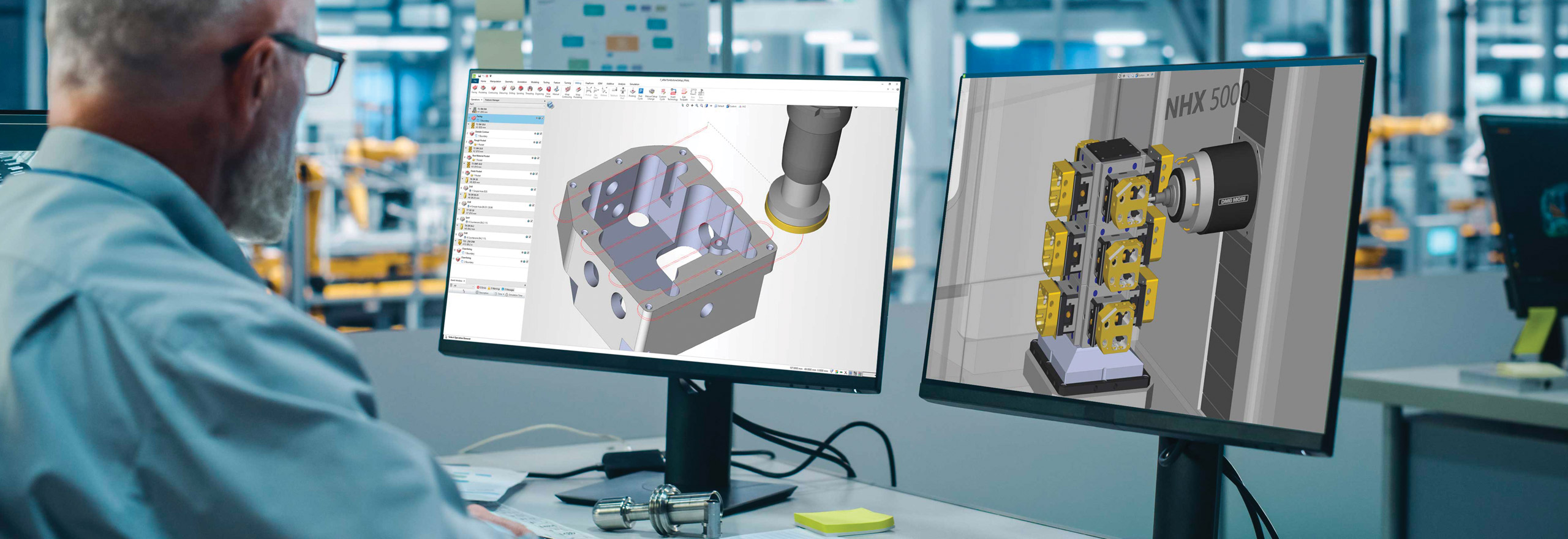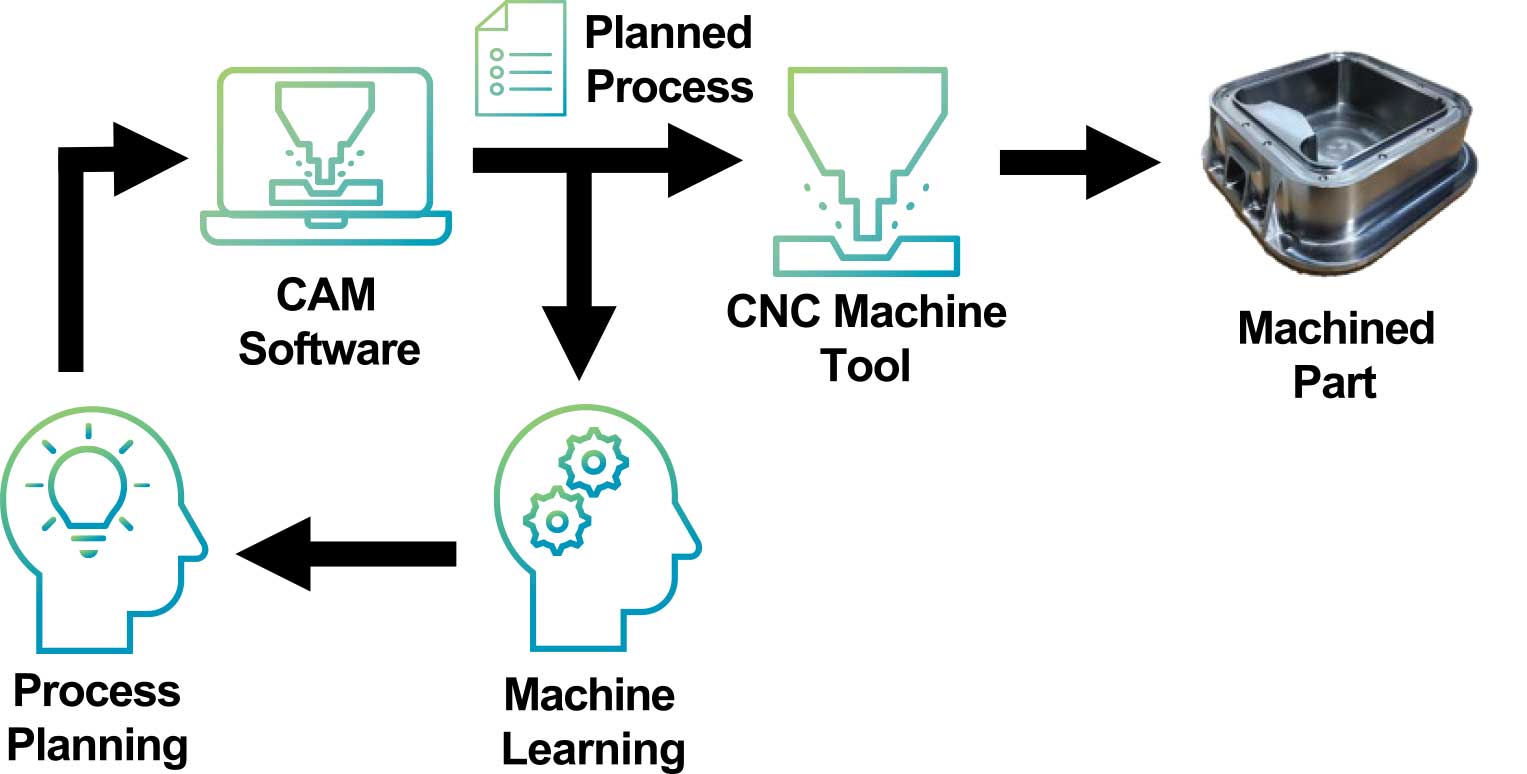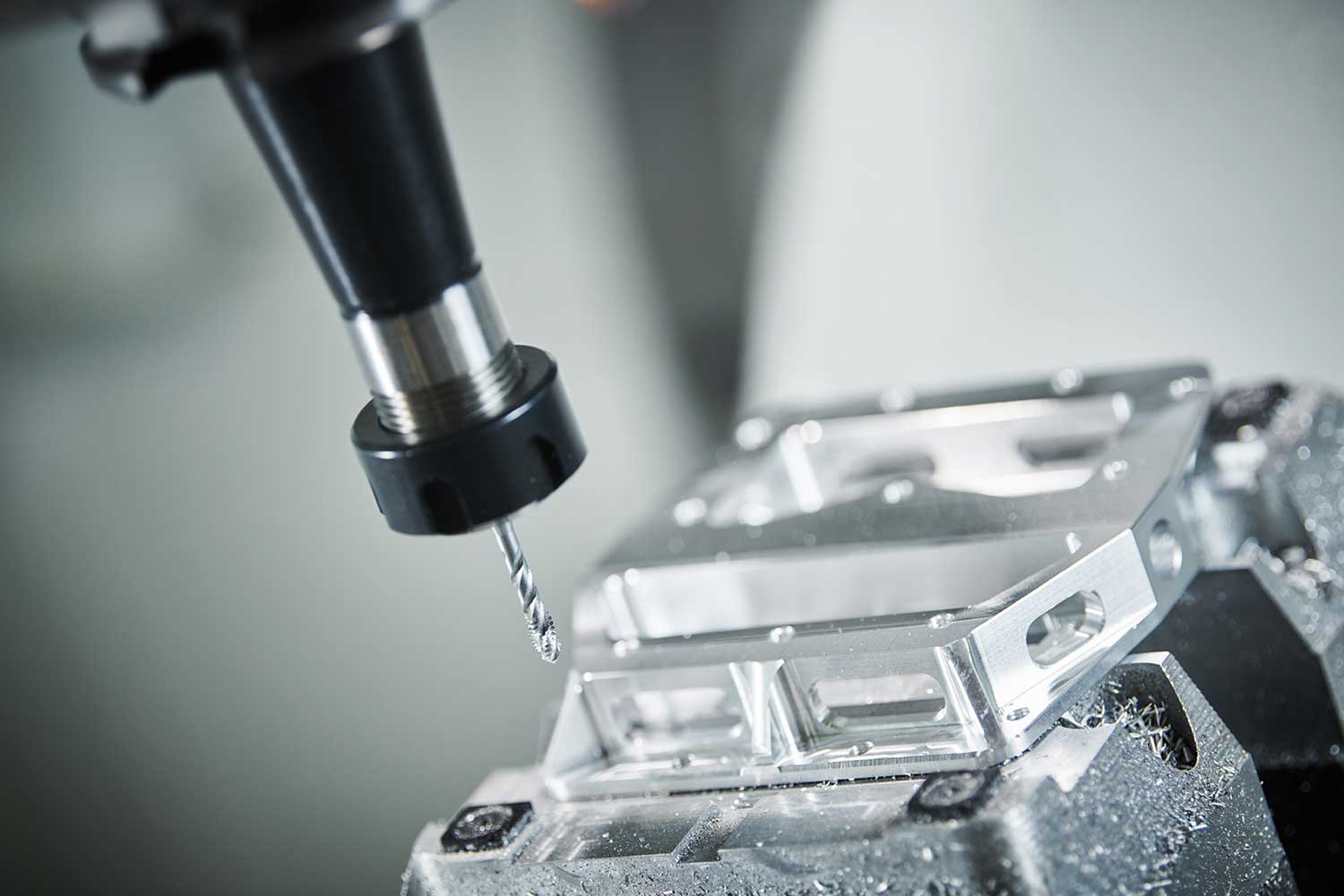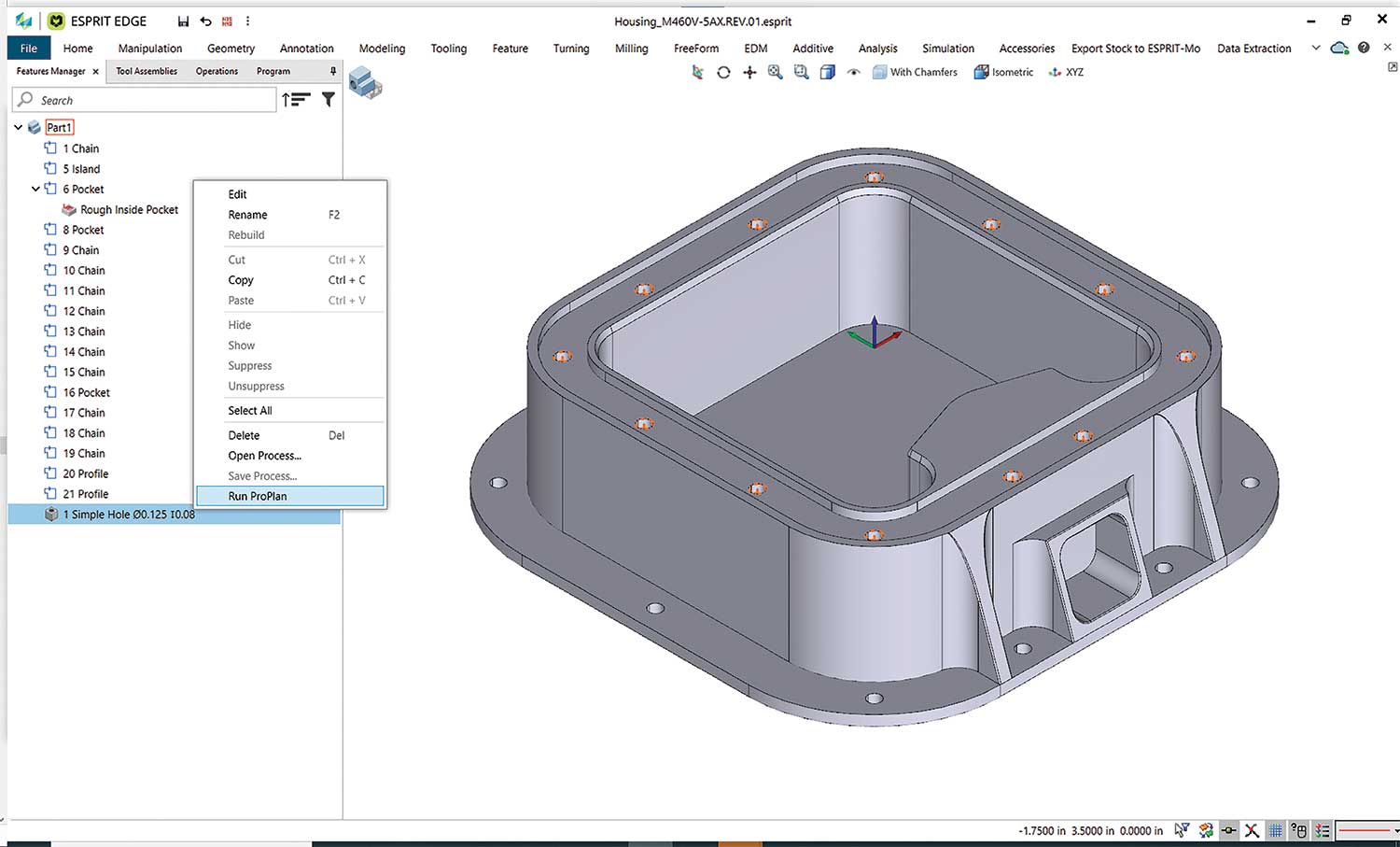Werkzeugwege schneller erstellen
Neue KI-basierte Technologielösung als nächster Entwicklungsschritt in der CAM-Programmierung Ryan Pembroke, Product Manager, Hexagon, Manufacturing Intelligence Division

Engineering Reality 2024 Ausgabe 1
Accelerate Smart Manufacturing
Mithilfe künstlicher Intelligenz (KI) bei der computergestützten Prozessplanung hat Hexagon die Automatisierung in der CAM-Programmierung weiterentwickelt, damit Fertigungsunternehmen institutionelles Wissen schneller, einfacher und konsequenter anwenden können. ProPlanAI von Hexagon bietet neue Automatisierungslösungen, die von Hexagons cloudbasiertem Kollaborationstool Nexus unterstützt werden.

Die Software verkürzt die Programmierzeit um bis zu 75 % und analysiert automatisch vorhandene Programmdaten. So lassen sich ganz ohne den Einsatz von RBA Ergebnisprognosen erzielen, die perfekt auf die jeweiligen Präferenzen, Produktionskapazitäten und Anforderungen zugeschnitten sind. Lern- und anpassungsfähige Technologie. Ohne zusätzlichen Bedienaufwand bietet diese höhere Programmierkonsistenz, Prozesssicherheit und bessere Erfassung institutionellen Wissens.
Regeln neu definieren
Wissenserhalt war ein wesentliches Ziel bei der Entwicklung von RBA im Hinblick auf die Anwendung von Programmierregeln basierend auf Material, Oberflächenbeschaffenheit, Merkmalseigenschaften etc. Die Implementierung ist zeitaufwändig und mühsam. Und bereits geringe Abweichungen bei den Fertigungsszenarien erschweren ihren konsequenten Einsatz. Neue Machine-Learning-Tools zur Programmierung von Automatisierungslösungen bewahren nun auch die Expertise von Mitarbeitern, die nicht mehr im Unternehmen sind.
Anstelle von Bedingungen ('Wenn-Dann-Befehle'), nutzt ProPlanAI bestehende CAM-Programme als Bausteine für ideale Prozesse. So definiert eine RBA-Regel beispielsweise, dass bei einem Bohrungsdurchmesser und einer Bohrungstiefe von jeweils 25 mm ein spezifisches Bohrverfahren anzuwenden ist. Beträgt der Durchmesser jedoch 15 und die Tiefe 50 mm, solle ein anderes Verfahren zum Einsatz kommen. In beiden Fällen legt der Anwender oder ein beauftragter CAM-Anbieter diese spezifischen Regeln fest.

Maschinelles Lernen hingegen nutzt vorhandenes Wissen sowie Programmierdaten aus früheren, validierten CAM-Programmen anstelle hochspezifischer Regeln. ProPlanAI lernt sowohl anhand weniger Aufträge als auch Hunderter oder Tausender vergangener Szenarien und identifiziert unmittelbar ein validiertes Fertigungskonzept, das genau auf den aktuellen Auftrag zugeschnitten ist.
Effiziente Datennutzung
Der wohl größte Vorteil von ProPLanAI besteht darin, alle bereits vorhandenen Planungsdaten optimal zu nutzen. ProPlanAI wählt automatisch Strategien aus, die Verfahren des jeweiligen Fertigungsunternehmens am besten widerspiegeln. Während Serienfertiger eher von RBA profitieren, sehen Lohnfertiger keinen Nutzen im Implementieren von Automatisierungslösungen, die nicht durchgängig einsetzbar sind. Von KI-gestützter Programmierautomatisierung profitieren sowohl Serien- als auch Lohnfertiger. Zum einen nutzt diese bereits im Betrieb vorhandene Daten und zum anderen erfordert deren Implementierung nur wenig Vorleistung.
Auf Knopfdruck wird aus einer Vielzahl bereits bestehender Verfahren der für das zu bearbeitende Merkmal am besten geeignete Bearbeitungsprozess gewählt. Nutzt ein Unternehmen beispielsweise bevorzugt bestimmte Verfahren beim Fräsen offener und geschlossener Taschen, erkennt der Lernalgorithmus die entsprechenden Datenmuster und schlägt automatisch die präferierte Bearbeitungsvariante vor. Beim Programmieren eines neuen Merkmals, kann ProPlanAI ähnliche bereits programmierte Merkmale identifizieren. Der Prozess lässt sich vom Anwender dann entsprechend anpassen und ProPlanAI speichert diese neuen Informationen.
ProPlanAI kann seine Machine-Learning-Modelle anhand identifizierter Gemeinsamkeiten und Unterschiede innerhalb weniger Minuten umtrainieren oder neu trainieren. Ein zu bearbeitendes Merkmal beispielsweise könnte zwei oder drei Bearbeitungsvorgänge erfordern, eine Bearbeitung aus 50 oder 60 verschiedenen Parametern bestehen und es könnten bereits 30 Merkmalsinstanzen aus früheren Projekten vorliegen. ProPlanAI analysiert und gruppiert nun alle Merkmals- und Bearbeitungsdaten und erstellt Modelle mit validierten Parametersätzen, die sich bei der nächsten Merkmalsprogrammierung erneut verwenden lassen.

CAM-Weiterentwicklung
Gerade angesichts des aktuellen Fachkräftemangels profitieren Fertigungsunternehmen nicht nur von einer besseren Datennutzung, sondern auch davon, dass vor allem weniger erfahrene CNC-Programmierer entsprechende Tools zur Verfügung haben, um auch schwierige Aufgaben sicher zu bewältigen. Da die Hersteller beim Programmieren ihre eigenen Daten nutzen, spiegeln die Prognosen automatisch diese internen Datenquellen sowie die von ihnen produzierten Bauteile und eingesetzten Werkzeugmaschinen wider.
CNC-Programmierer profitieren sofort von der Automatisierung durch KI. Die Technologie optimiert jedoch nicht nur die Bauteilprogrammierung. Sie kann auch zu Abweichungen von Programmierstandards benachrichtigen sowie die Nutzung von PMI (Product Manufacturing Information) verbessern, um einen noch höheren Automatisierungsgrad bei der CNC-Programmierung zu erzeilen.
Zwar stehen seitens CAM-Softwareentwicklung bereits seit Jahren Automatisierungstools zur Verfügung, die institutionelles Wissen bewahren und anwenden, doch aufgrund der mangelnden Flexibilität herkömmlicher Automatisierungslösungen ist es für Fertigungsunternehmen im dynamischen Branchenumfeld schwer, entsprechend agil zu bleiben. Im Hinblick auf Fachkräftemangel und zunehmende Komplexität von Bauteilen und Maschinen bietet KI höhere Flexibilität, Konsistenz und Effizienz. Die KI-gestützte Programmierung erfasst und generiert automatisierte Lösungen, die dem Unternehmen bestmöglich entsprechen. Sie spart Zeit, schont Ressourcen wie Werkzeugmaschinen und Schneidwerkzeuge und führt zu besseren Ergebnissen.

